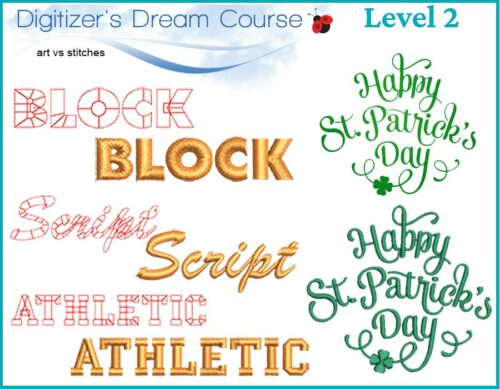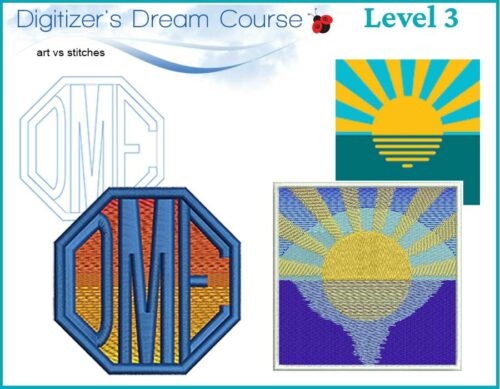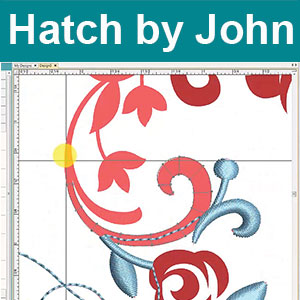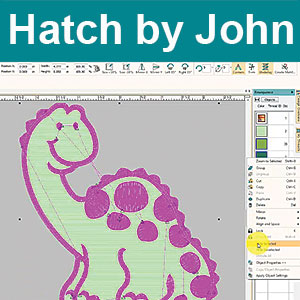-
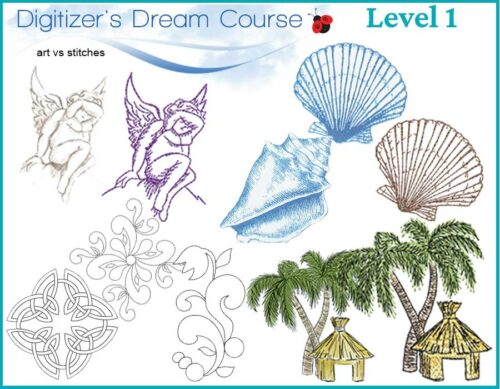 Level 1 is where we suggest everyone starts whether you’re completely new to digitizing or have been at it for a while. In this level, you’ll learn some of embroidery’s best kept ‘secrets’ & build a solid foundation of embroidery theory. This lesson heavily focuses on the running stitch as it is the primary stitch type used in machine embroidery.
Level 1 is where we suggest everyone starts whether you’re completely new to digitizing or have been at it for a while. In this level, you’ll learn some of embroidery’s best kept ‘secrets’ & build a solid foundation of embroidery theory. This lesson heavily focuses on the running stitch as it is the primary stitch type used in machine embroidery. -
 Complete the Digitizer’s Dream Course series with levels 2 & 3. Whereas Level 1 teaches you the theory and rules behind using the running stitch, levels 2 and 3 focus on the satin and fill stitches. These 3 stitch types are the pillars of machine embroidery. Once you’ve mastered them, the sky is the limit with this beautiful art!
Complete the Digitizer’s Dream Course series with levels 2 & 3. Whereas Level 1 teaches you the theory and rules behind using the running stitch, levels 2 and 3 focus on the satin and fill stitches. These 3 stitch types are the pillars of machine embroidery. Once you’ve mastered them, the sky is the limit with this beautiful art! -
-
-
 Level 1 is where we suggest everyone starts whether you’re completely new to digitizing or have been at it for a while. In this level, you’ll learn some of embroidery’s best kept ‘secrets’ & build a solid foundation of embroidery theory. This lesson heavily focuses on the running stitch as it is the primary stitch type used in machine embroidery.
Level 1 is where we suggest everyone starts whether you’re completely new to digitizing or have been at it for a while. In this level, you’ll learn some of embroidery’s best kept ‘secrets’ & build a solid foundation of embroidery theory. This lesson heavily focuses on the running stitch as it is the primary stitch type used in machine embroidery. -
-
-
 Complete the Digitizer’s Dream Course series with levels 2 & 3. Whereas Level 1 teaches you the theory and rules behind using the running stitch, levels 2 and 3 focus on the satin and fill stitches. These 3 stitch types are the pillars of machine embroidery. Once you’ve mastered them, the sky is the limit with this beautiful art!
Complete the Digitizer’s Dream Course series with levels 2 & 3. Whereas Level 1 teaches you the theory and rules behind using the running stitch, levels 2 and 3 focus on the satin and fill stitches. These 3 stitch types are the pillars of machine embroidery. Once you’ve mastered them, the sky is the limit with this beautiful art! -
 Level 1 is where we suggest everyone starts whether you’re completely new to digitizing or have been at it for a while. In this level, you’ll learn some of embroidery’s best kept ‘secrets’ & build a solid foundation of embroidery theory. This lesson heavily focuses on the running stitch as it is the primary stitch type used in machine embroidery.
Level 1 is where we suggest everyone starts whether you’re completely new to digitizing or have been at it for a while. In this level, you’ll learn some of embroidery’s best kept ‘secrets’ & build a solid foundation of embroidery theory. This lesson heavily focuses on the running stitch as it is the primary stitch type used in machine embroidery. -
 Level 1 is where we suggest everyone starts whether you’re completely new to digitizing or have been at it for a while. In this level, you’ll learn some of embroidery’s best kept ‘secrets’ & build a solid foundation of embroidery theory. This lesson heavily focuses on the running stitch as it is the primary stitch type used in machine embroidery.
Level 1 is where we suggest everyone starts whether you’re completely new to digitizing or have been at it for a while. In this level, you’ll learn some of embroidery’s best kept ‘secrets’ & build a solid foundation of embroidery theory. This lesson heavily focuses on the running stitch as it is the primary stitch type used in machine embroidery. -
 Level 1 is where we suggest everyone starts whether you’re completely new to digitizing or have been at it for a while. In this level, you’ll learn some of embroidery’s best kept ‘secrets’ & build a solid foundation of embroidery theory. This lesson heavily focuses on the running stitch as it is the primary stitch type used in machine embroidery.
Level 1 is where we suggest everyone starts whether you’re completely new to digitizing or have been at it for a while. In this level, you’ll learn some of embroidery’s best kept ‘secrets’ & build a solid foundation of embroidery theory. This lesson heavily focuses on the running stitch as it is the primary stitch type used in machine embroidery. -
 Complete the Digitizer’s Dream Course series with levels 2 & 3. Whereas Level 1 teaches you the theory and rules behind using the running stitch, levels 2 and 3 focus on the satin and fill stitches. These 3 stitch types are the pillars of machine embroidery. Once you’ve mastered them, the sky is the limit with this beautiful art!
Complete the Digitizer’s Dream Course series with levels 2 & 3. Whereas Level 1 teaches you the theory and rules behind using the running stitch, levels 2 and 3 focus on the satin and fill stitches. These 3 stitch types are the pillars of machine embroidery. Once you’ve mastered them, the sky is the limit with this beautiful art! -
Sale!
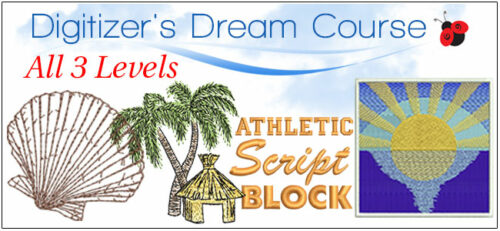 This bundle includes all three levels of the Digitizer’s Dream Course. With this course, you’ll learn some of embroidery’s best kept ‘secrets’ & build a solid foundation of embroidery theory. Each level focuses on 1 of the 3 primary stitch types. Level 1 focuses on the running stitch, level 2 on the satin stitch, and level 3 on the fill stitch. EVERY stitch type in existence is a simple variation of 1 of these 3 stitch types. Master these stitch types, and the creative possibilities are endless!
This bundle includes all three levels of the Digitizer’s Dream Course. With this course, you’ll learn some of embroidery’s best kept ‘secrets’ & build a solid foundation of embroidery theory. Each level focuses on 1 of the 3 primary stitch types. Level 1 focuses on the running stitch, level 2 on the satin stitch, and level 3 on the fill stitch. EVERY stitch type in existence is a simple variation of 1 of these 3 stitch types. Master these stitch types, and the creative possibilities are endless! -
 Complete the Digitizer’s Dream Course series with levels 2 & 3. Whereas Level 1 teaches you the theory and rules behind using the running stitch, levels 2 and 3 focus on the satin and fill stitches. These 3 stitch types are the pillars of machine embroidery. Once you’ve mastered them, the sky is the limit with this beautiful art!
Complete the Digitizer’s Dream Course series with levels 2 & 3. Whereas Level 1 teaches you the theory and rules behind using the running stitch, levels 2 and 3 focus on the satin and fill stitches. These 3 stitch types are the pillars of machine embroidery. Once you’ve mastered them, the sky is the limit with this beautiful art! -
-
 Level 1 is where we suggest everyone starts whether you’re completely new to digitizing or have been at it for a while. In this level, you’ll learn some of embroidery’s best kept ‘secrets’ & build a solid foundation of embroidery theory. This lesson heavily focuses on the running stitch as it is the primary stitch type used in machine embroidery.
Level 1 is where we suggest everyone starts whether you’re completely new to digitizing or have been at it for a while. In this level, you’ll learn some of embroidery’s best kept ‘secrets’ & build a solid foundation of embroidery theory. This lesson heavily focuses on the running stitch as it is the primary stitch type used in machine embroidery. -
-
 Complete the Digitizer’s Dream Course series with levels 2 & 3. Whereas Level 1 teaches you the theory and rules behind using the running stitch, levels 2 and 3 focus on the satin and fill stitches. These 3 stitch types are the pillars of machine embroidery. Once you’ve mastered them, the sky is the limit with this beautiful art!
Complete the Digitizer’s Dream Course series with levels 2 & 3. Whereas Level 1 teaches you the theory and rules behind using the running stitch, levels 2 and 3 focus on the satin and fill stitches. These 3 stitch types are the pillars of machine embroidery. Once you’ve mastered them, the sky is the limit with this beautiful art! -
-
-
-
-
-
0

